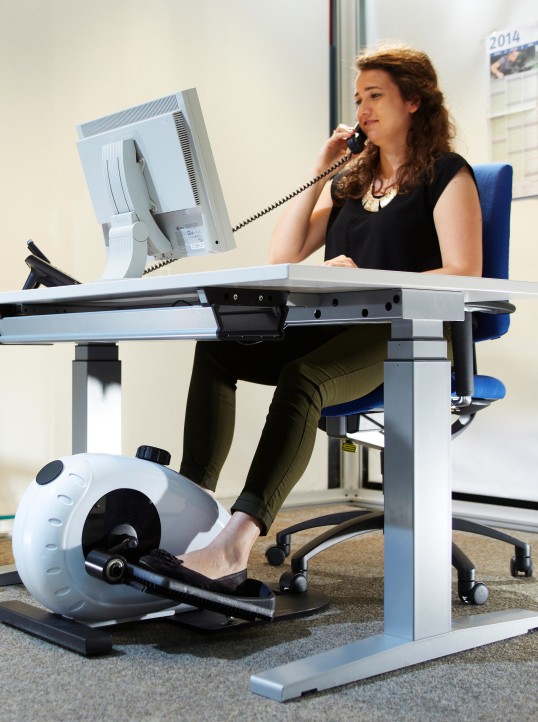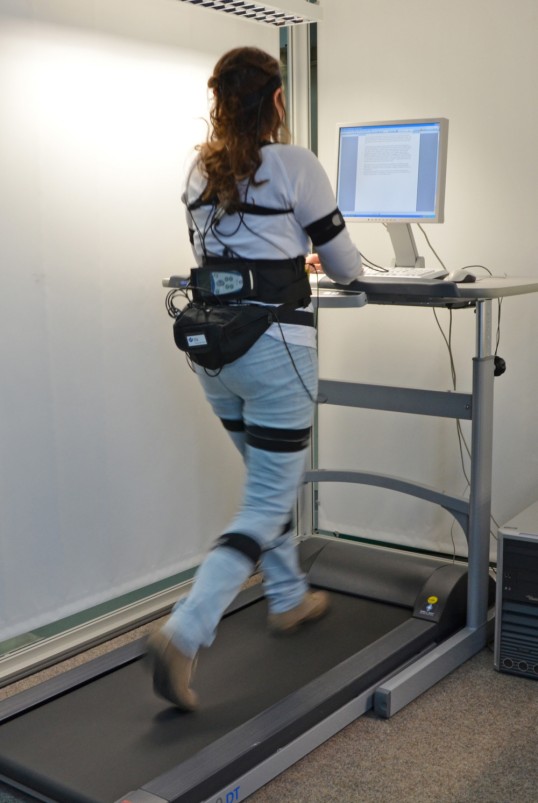- Artificial Intelligence (AI)
- Occupational exposure limit values
- Climate Change and Occupational Safety
- List of CMR substances
- Electromagnetic fields
- Ergonomics
- Industrial Security
- Collaborative robots
- Noise
- Nanoparticles at the workplace
- Optical Radiation
- REACH
- Reference materials
- Proficiency testing
- Vibration
- Virtual reality
- Work 4.0
Ergonomic studies during seated tasks
Studies into the promotion of physical activity by means of dynamic office workplaces
The number of office and VDU workplaces continues to rise. It is therefore assumed that physical inactivity at the workplace is also on the increase. This development could be associated with increased risks for the musculoskeletal and cardiovascular systems. A number of concepts have therefore been developed in recent years for "dynamic office workplaces" which combine light physical activity with office tasks.
In conjunction with the Dutch "TNO Work and Employment" institute, the IFA systematically studied the effect of such workstations upon selected biomechanical, physiological and subjective parameters. Measurements were performed in a laboratory study on twelve test subjects at two different types of dynamic workplace (treadmill and exercise cycle with ergometer) and at a standard office workplace (reference for standing and sitting). The study design comprised measurements with the CUELA Activity System, electromyography (EMG) and electrocardiography (ECG), measurements of the work performance during five standardized office tasks, and a survey of the test subjects' subjective impressions.
The results revealed higher values for the physical activity, the heart rate and the metabolic rate at the dynamic workplaces compared to the reference workplaces. Conversely, the muscle activity was significantly changed in only a few cases, and the body posture did not differ substantially from that at the conventional seated workplace. Although the test subjects assessed their work performance as poorer compared to the reference, the objective results revealed no significant differences, with only one exception.
At the present time it is questionable whether the "dynamic" alternatives will be of relevance to office workplaces in everyday vocational life. The dynamic workplaces tested exhibited certain deficits in their ergonomic design and in their safety during use. The workplaces are however undergoing constant further development, and more recent versions of the dynamic workplaces are already improved in their ergonomic design and require less space. It is conceivable that physical activity at office workplaces can be increased in the future by the supplementary use of dynamic workstations, for example by temporary use or optional provision on loan for several workers.
Ergonomic study of special office chairs
Frequent and sustained work in a static seated posture may lead to muscle tension and spinal disorders at VDU and office workplaces. This can cause both excessive stress upon the muscular system, particularly in the neck and shoulder region, and functional underloading of certain muscle groups, such as the back and abdominal muscles. The concept of dynamic sitting has therefore been promoted in recent years in the development of office chairs. Some chair manufacturers have used design elements, such as dynamic mounting or inherent spin of the seat surface, to create particular chair properties which promote dynamic sitting and thus assist in preventing musculoskeletal diseases at office and VDU workplaces.
In the light of these developments, the VBG (the institution for statutory accident insurance and prevention in the administrative sector) initiated an ergonomic study in which four special dynamic office chairs were evaluated in comparison with a conventional office chair. The study was conducted in conjunction with the IFA and the Dutch TNO Work and Employment institute. The objective of the study was to find answers to the following questions:
- Do specific dynamic chairs lead to a significant increase in physical/muscular activity at VDU and office workplaces in comparison to a conventional office chair?
- Do employees working at VDU and office workplaces experience the special chairs subjectively as beneficial to their health when compared to a conventional office chair, and do they accept the chairs in their everyday work?
In order to find answers to these questions, a representative VDU/office workplace was created in a laboratory environment with which the sitting and movement behaviour of ten laboratory test subjects performing standardized office tasks could be analysed by means of measurements and standardized interviews. In addition, measurements and surveys of 40 test subjects in total in four different companies were conducted under real-case conditions.
For the purpose of the study, a measurement system based upon the CUELA system was developed and employed. This system permits ergonomic analysis of stress and strain parameters synchronous to office chair adjustment parameters, in both laboratory and field environments.
Further information

Concluding reports
Active Workplace: Effekte dynamischer Arbeitsstationen (Effects of dynamic workstations)
(IFA Report 3/2018, in German, summary in English)
Untersuchung von dynamischen Büroarbeitsplätzen (Study of dynamic office workstations)
(IFA Report 4/2014, in German, summary in English)
Entwicklung und Evaluation eines Bewegungsmesssystems zur Analyse der physischen Aktivität (Development and evaluation of a movement measurement system for the analysis of physical activity)
IFA-Report 2/2011 (in German, summary in English)
Ergonomische Untersuchung besonderer Büroarbeitsstühle (Ergonomic study of special office chairs)
BGIA-Report 5/2008 (in German, summary in English)
Further media
CUELA activity system for analysis of physical activity
Focus on IFA's work No 0311 (PDF, 105 kB, non-accessible)
Laboratory study of the efficacy of dynamic office workstations
Focus on IFA's work No 379 (PDF, 131 kB, non-accessible)
Workshop
"Prevention of physical inactivity at office workplaces" on
10th of June 2015: Presentations for download

